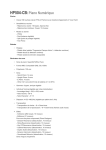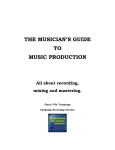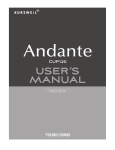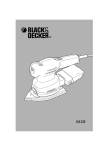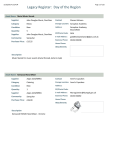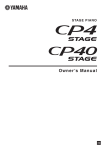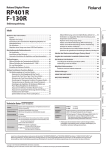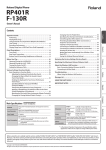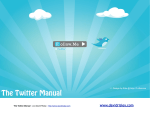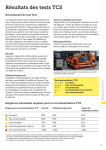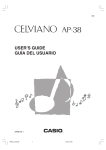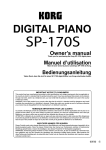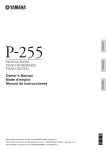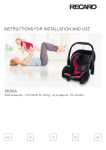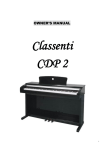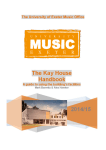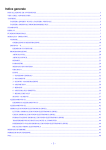Download “The Digital Piano Bible”
Transcript
“The Digital Piano Bible” 7 Things You MUST Know Before You Buy a Digital Piano Important note: To follow any link in this guide you must hover over the link, hold down the ctrl key then click on the link. Author: Graham Howard “You are welcome to print out this guide for personal use”, but please be warned, there’s about 75 pages. Sorry, I got a bit carried away with it! “My digital piano buyer’s guide will help you choose a piano that’s right for you and your family”, Graham Howard If you've just started out looking for a digital piano, or you've been researching for a while and can't make that important final decision then you'll find the information in this book invaluable... This book will help you make the right decisions and, probably even more importantly, stop you from making VERY expensive mistakes. Buying a digital piano isn’t something you do often. Well, hopefully not if you get it right the first time! After you've digested the detailed information this book you will no longer be an easy target for salespeople... In fact, you'll most likely be more knowledgeable than the salesperson themselves! I wish you many years of enjoyment with your, soon to be, new digital piano. Oh, and just one more thing... I update this book weekly, so if you want the latest copy, just send me an email: [email protected] This book was last updated on 23/11/2015. Here’s what you’re going to get: 1) How to Understand Confusing Terminology ('Piano Geek Speak') 1 You’re going to find out what the following terms mean: (a) Weighted keys - [page 4] (b) Touch sensitive keys (and dynamic levels) - [page 7] (c) Graded hammer action - [page 10] (d) Mechanism with escapement - [page 11] (e) Key weight control - [page 12] (f) GHS/GH/GH3 key touch - [page 12] (g) Keyboard split - [page 13] (h) Polyphony - [page 13] (i) Midi IN/OUT (USB) - [page 14] (j) Aux IN/OUT - [page 14] (k) Record facility - [page 14] (l) Built-in metronome - [page 15] (m) Speaker wattage - [page 15] (n) Transpose - [page 16] (o) Reverb - [page 16] (p) Dual voice - [page 16] (q) String resonance - [page 17] (r) Key off samples - [page 17] (s) Brilliance - [page 18] (t) Scale tuning - [page 18] (u) Display screen - [page 18] 2) Common Digital Piano Questions (a) Are wooden keys better than plastic keys? - [page 20] (b) How much polyphony do I need: 32, 64, 96, 128 or more? - [page 21] (c) How much speaker wattage do I need? - [page 22] (d) What's the difference between digital and stage pianos? - [page 22] (e) Where are the best and worst places in my home to put a digital piano? - [page 24] (f) How do I protect my piano from drink spills, dust and cup stains? - [page 25] (g) Are wooden mechanisms a good thing, or could they be a risky purchase? - [page 27] (h) Are warranties transferable on digital pianos? – [page 27] (i) What’s the average life of a digital piano? – [page 28] 3) The Disadvantages of Buying a Second hand Digital Piano, Versus a New One 4) 6 Simple Tests You Can Do In A Piano Store Before Making Your Decision. DON'T BUY If The Digital Piano Doesn't Pass All 6! (a) Stand at a distance and get someone to play - [page 32] (b) Turn the volume off, or right down. Are the keys noisy or clicky? - [page 32] (c) Do the keys move a lot from side to side? - [page 33] (d) Are the keys touch sensitive? - [page 33] 2 (e) How much resistance (weight) do you feel on the keys? - [page 34] (f) How long does the sound sustain? - [page 35] 5) A Complete List of Digital Piano Brands. And The Top Digital Piano Brands Scored On: (a) Selection (top 6 brands) - [page 38] (b) Reliability (top 10 brands) - [page 42] (c) Long term popularity (top 5 brands) - [page 47] (d) Recent popularity (top 5 brands) - [page 49] (e) Overall result (top 16 brands) - [page 49] 6) Which Digital Pianos Are The Best? (a) The top ten lists of piano models. Rated on: touch, sound, design, build quality, reliability, resale value, popularity, and value for money - [page 50] (b) The top ten list of piano models in each of four categories: the best under £500, the best from £500 to £700, the best from £700 to £1000, and the best over £1,000 - [page 58] 7) Should You Buy Online Or In A Physical Store? (a) The advantages and disadvantages of both - [page 65] (b) A list of trusted online and offline stores – (website and contact details included) - [page 66] (c) Two simple ways to find out if a store is legitimate - [page 73] (d) How to GUARANTEE your money is safe when you buy online – even if the store goes bust! - [page 74] ... So let's get started! 1) How to Understand Confusing Terminology ('Piano Geek Speak') Are you confused about all the different terminology that's being used? If you are, then I'm not surprised! Here’s a typical scenario... You walk into a piano shop and you're greeted with a warm “hello, how can I help you?” You explain that you want to buy a piano for your son or daughter, and you need some advice. Should be simple, right? Well... 3 The salesperson starts to ramble on about GHE and GH mechanisms, polyphony, graded hammer action, touch sensitivity, escapement, dual voice, split keyboard, etc. This is something you probably didn't expect. After all, how can buying a piano be so complicated? So you walk out of the shop completely confused. You then go online to do some research. This is when it gets even worse... The same terminology you heard in the piano shop starts appearing in the descriptions of the pianos on websites. What does it all mean? There are many, many different terms used to describe the different parts and functions of the piano. Manufacturers also use their own wording as well. Now I'm going to explain the most common terms. So the next time you're confronted with 'Piano Geek Speak', you'll nod your head in complete understanding. Here we go... (a) Weighted keys Most digital pianos have different key weighting. You'll likely come across terminology such as: Light-weighted Semi-weighted Weighted Medium-weighted Fully-weighted The difference between the above key weights is only slight. Ideally you should aim to get a piano that has a fully weighted touch. These pianos are usually more expensive though... So, settling for a medium-weighted key touch is the next best option. 4 Please note: Manufacturers usually write their own piano descriptions. So THEY choose the terminology to describe their key touch. This can often be very misleading... I've seen pianos described as having fullyweighted keys, when they really only have medium-weighted keys. On the other end of the scale I've seen pianos described as fully-weighted keys – but their touch is WAY too heavy, and has so much resistance that a master rock climber would get finger ache playing them! It’s not good to learn on such a piano... If you spend too much time pressing down on hard or stiff, heavily resistant keys, you’ll end up with a very poor technique... And you’ll find it extremely difficult to control the key touch on an upright or grand piano. I’ve seen it happen so many times. These pianos are misleadingly advertised as 'weighted', and, really, should be renamed 'super heavy-weighted' (like the big boxers)... Tip/ Pianos that have a ‘super heavy-weighted’ key touch are usually easy to spot. Here are some give-away signs to look out for: (i) They usually sell between £299 and £400. But I’ve seen some selling at higher prices (ii) Sometimes they’re marked down from an extremely inflated ‘retail’ price that gives the appearance of a ‘real bargain’ (iii) They’re not one of the well-known brand names. And they certainly don’t appear in the top 10 or top 20 lists you’ll see later in this book. If you’ve seen a brand new piano for sale in the £299 to £400 price range that didn’t make my top 10 under £500 list, be very cautious! If you have any doubts at all just send me an email: [email protected] 5 The list below describes the 'actual' key weight of the most popular makes and models. I put together this list over a 6 month period by playing, feeling and testing the weight and resistance of the piano key's down stroke and up stroke. Light-weighted Examples of light-weighted keys: Yamaha PSR, EZ, YPT, DGX230, DGX530, NP11, NP31, NP-V60, NP-V80 Casio CTK and LK models Korg PA models Digital pianos can have semi-weighted, weighted, medium-weighted or fully-weighted keys... This means the key touch is heavier than typical 61 key electronic keyboards with a light-weighted key touch. Fully-weighted keys feel closest to an upright or grand piano. Semi-weighted Examples of semi-weighted keys: Chase (all models) Gear4Music (SP, DP and V models) Hemingway (all models) Mantova (all models) Suzuki (all models) Thomann (All models except DP50) Williams (all models) Weighted Examples of weighted keys: Casio CDP130, CDP220 Galileo (all models) Orla (all models) Thomann DP50 Medium-Weighted Examples of medium-weighted keys: Broadway B2 Casio AP Celviano and PX Privia range 6 Kawai CL26, CL36, KDP90, ES100 Korg SP170S, SP280, LP380 Kurzweil KA110 Yamaha DGX650, P45, P115, YDP142, YDP-V240 Fully-Weighted Examples of fully-weighted keys: Broadway EZ-102, B1, B3, BG1, MK10, BA1 Classenti CDP1, CDP2, CDP3i, UD1, DG1, GR1i Kawai CN25, CN35, CA17, CA67, CA97, CS4, CS7, CS10, ES7 Kurzweil M210, M1, M3W, MPS10, MPS20, MP10F, MP15, MP20F, CUP2, CUP110, CUP2A, MPG200, CGP220W Roland RP401R, F-140R, RD800, F-20, FP-50, FP-80, HP504, HP603, HP605, HPi-50e, LX7, LX17, DP-90e, DP-90Se Yamaha YDP-S52, YDP162, YDP181, CLP525, CLP535, CLP545, CLP575, CLP585, CLP565GP, CVP701, CVP705, CVP709, CVP709GP, P255, CP300, NU1, N1, N2, N3 Notes: Fully-weighted feel closest to playing a real piano. (b) Touch sensitive keys (and dynamic levels) When you press the piano key down softly, you hear a quiet sound. When you press it with force, you hear a loud sound. And there are various degrees in between. ‘Touch sensitive’ means: the harder you strike the key, the louder the sound. Or, to be technically correct, the faster the key goes down, the louder the sound. So, it's very important to buy a digital piano that has as many touch sensitive levels as possible. Now here comes the confusing part. Different terminology is used by manufacturers to describe these different levels of touch sensitivity. Here are some of the common jargon words you’ll come across: Touch sensitivity levels Touch response levels Dynamic levels What gets even more confusing is when the above terms are incorrectly used to describe something completely different. For example key weight... 7 Some pianos have a feature that allows you to set the key weight to ‘feel’ differently when you play. So you can get a louder sound by pressing the keys down lightly, for instance. But I won’t go into this right now. So... now back to touch sensitive keys... The term I will use from now on to describe how many levels of touch sensitivity a piano has is: ‘Dynamic levels’. If you want to cut through the jargon and really know how many dynamic levels a specific piano has, then just send an email to: [email protected] and I’ll tell you. If you practice on a piano or keyboard that doesn't have dynamic levels you'll end up with bad habits and a very poor technique. This is a real disaster because if you ever want to play a real piano, you'll find it really difficult to adapt. Digital pianos vary in the number of dynamic levels they offer. You get anything from 1 to 6 levels. Most cheap digital pianos have between 1 and 3 levels. But the more levels the better! The more popular makes such as Yamaha, Roland, Kawai, Casio, Classenti, Broadway and Kurzweil have between 3 to 6 dynamic levels. Most of their basic pianos have 3 or 4 levels, their mid-range has 4 levels, and their very best pianos have 5 or 6 levels. Here’s what dynamic levels means: Pushing down a piano key with a different force produces a louder or softer sound. It has nothing to do with the weight of the key; only the force required to adjust the sound of each note. So, hitting the key hard produces a loud sound, and pushing it down gently produces a soft sound. A real, acoustic piano has a huge number of dynamic levels. It all depends on the velocity of the hammer as it strikes the string. But even the highly trained ear of a piano tuner can distinguish only 6 or 7, or maybe 8 at a struggle. 8 Digital pianos try to replicate this. Some do it quite well, and others, poorly. Important: A minimum of 4 dynamic levels is essential. If you practice on a digital piano that has a restricted number of dynamic levels, you will develop a poor technique. You’ll find it really difficult to play music with expression. This is a serious disadvantage because most music changes in volume. What's more, when the time comes to play an upright or grand piano, you'll struggle to adapt... and you’ll find yourself playing too loudly most of the time. This is because you've been used to thumping the keys to get a louder sound. So you’ll have to re-train your fingers in order to play with expression. And that's a lot of work! In musical terms, here’s a summary of the dynamic levels used on digital pianos: 3 4 5 6 levels: levels: levels: levels: mp, mf, f mp, mf, f, ff -- or sometimes: p, mp, mf, f p, mp, mf, f, ff pp, p, mp, mf, f, ff Notes: Your piano MUST have touch sensitive keys. The more dynamic levels the better -This is absolutely essential... I recommend buying a piano that has at least 4 levels. You can get up to about grade 7 with 4 levels. To go above grade 7 you need 5 levels. If you want know how many dynamic levels a specific piano has, just send an email to: [email protected] (c) Graded hammer action Here's the definition of graded hammer action: "With heavier key weighting in the bass (left-hand end) getting gradually lighter as you go up the keyboard (towards the right)...” This mimics the exact feel of an upright or grand piano. 9 Upright and grand pianos have hammers. The hammer strikes the string which then produces the sound. On an upright or grand piano, the strings are thick in the bass (left end). The strings get gradually smaller in diameter as they go up towards the top treble (right end). To achieve an even sound the hammers have to be different sizes: Large in the bass, getting gradually smaller as they go up towards the treble... Different sized hammers affect the resistance of the key. The heaviest key is on the far left. The lightest key is on the far right. ** How do they replicate this on a digital piano? ** To achieve the same feel as an upright or grand piano, a digital piano's key weight must be designed to feel heavy in the bass and get gradually lighter as you go up the keyboard. The correct terminology is 'graded hammer action'. This term is used by Yamaha, Kawai, Kurzweil, Broadway and Classenti. ... Just to confuse you, some manufacturers use a different name for their graded hammer action... Why do they do that? The other names I've seen in use are: progressive hammer action, scaled hammer action, balanced hammer action, and linear graded hammer action. Here are those culprits: Yamaha use ‘linear graded hammer action’ on their latest Clavinova key action Roland use 'progressive hammer action'. Casio use 'scaled hammer action'. Suzuki use 'balanced hammer action'. Notes: The graded hammer action is not an important feature to have. (d) Mechanism with escapement You can feel the key escapement on an upright or grand piano when you press the key down VERY slowly. 10 When the key gets to the bottom of its travel you'll feel a slight jump. This jump is called the ‘escapement’, (or ‘set-off’). You can only feel this when no sound is made. Digital piano manufacturers have tried to copy this 'feel', but it's not beneficial, and doesn’t improve the actual piano’s touch. In some cases, when it has been overdone, the key touch can feel very lumpy. It's actually a fault on a real, acoustic piano! So why would a manufacturer try to replicate this fault? It doesn’t make any sense! It appears that most digital piano manufacturers attempt to copy all aspects of an acoustic piano without actually discovering whether it’s beneficial or not. This is complete madness! So, in short, key escapement is just another one of those gimmicks that increases the perceived value, enabling these digital pianos to sell at higher prices. You'll find this key escapement on Yamaha's top end CLP pianos, Roland's top end HP pianos, and Kawai's top end CA pianos. Recommendation: If the piano you intend buying has the escapement feature, sit down and play it for a while… close your eyes… feel the keys when you play softly and slowly. Then make sure you’re OK with the lumpy jumpy feel of the key when it reaches the bottom of its down stroke. (e) Key weight control Some digital pianos have the option of changing key weight. There are usually 3 settings: light, standard (which is the default) and heavy. The standard setting is BY FAR the most realistic touch... It's a nice idea to be able to change this setting, but, unfortunately, when you select anything 11 other than the standard key weight, the touch feels horribly wrong... With the heavy setting you get the sensation of the key being stiff and then jumping down. With the light setting you get a weird feeling, a little bouncy, and completely uncontrollable. So what's the point of having this setting if you can't use it? Unfortunately, it's yet another one of those sales gimmicks that either inflates the price of the piano or adds to its ‘perceived’ value. (f) GHS/GH/GH3 key touch This is Yamaha’s terminology for their different key mechanisms. GHS stands for 'Graded Hammer Standard'. This is Yamaha's basic key mechanism. The hammers are graded (see C above), but the touch is quite light. This can be found on their budget line: P45, P115 and YDP142. GH (also called GHE) is the next level up from GHS. This keyboard mechanism allows for greater expression (slightly more sensitivity in the keys). The GH key touch is slightly heavier than the standard GHS mechanism. GHE can be found in Yamaha's mid-range digital pianos: YDP162, YDP-S52, P255 and CP300. GH3 is Yamaha's Graded Hammer Premium' mechanism. The GH3 is an upgrade of the GH action. It includes sensors that allows for faster repetition. The GH3 can be found in the following digital pianos: CLP525, CVP601, CVP605, CVP609 and CVP609GP. Yamaha’s latest key actions are: GH3X and NWX. The GH3X is an upgrade of the GH3. And the NWX is a natural wood action. The GH3X key actions are in Yamaha’s latest Clavinova models: CLP535 and CLP565GP 12 Yamaha’s NWX key actions are used in the following models: CLP545, CLP575 and CLP585 (g) Keyboard split The keyboard split allows you to play a different voice (sound) over different parts of the keyboard. For example: You could choose a string bass from the G below middle C downwards, and a harpsichord from G# upwards. This is a useful feature to have if you intend being part of a group, or if you'll be giving live performances on your own. (h) Polyphony Most digital pianos today have the following polyphony: 32, 64, 96, 128, 192 or 256. Older pianos can have 16 or 32 note polyphony. This number represents how many sounds can be played at the same time. It also includes notes that are held down by the pedal. 64-note polyphony is probably more than you would ever need. However... If you desire a digital piano that has many different instrumental sounds, effects, rhythm, percussion, and sound layering, then you might need a higher polyphony if you use a few of these features at the same time... This is because when you combine multiple effects with complex chords and long sustained notes with the pedal, then the polyphony value can multiply. Recommendation: 32-note polyphony is OK for beginners; 64-note polyphony is good enough for nearly all types of music and complex pieces; and 128-note polyphony can come in handy for composers using multiple voices and effects. (i) Midi IN/OUT (USB) MIDI allows you to connect your piano to your computer. 13 This is a really useful feature. Whatever you play on your piano can be replicated in note form on your computer. This is great if you want to write your own music! And it’s essential if your child intends taking GCSE or A-level music. You'll need a USB to Midi cable and good music software such as Music Notation (http://budurl.com/musicnotation7) - ideal for Windows, or Sibelius (http://budurl.com/sibelius) - perfect for Macs. You can connect to other Midi devices such as a Midi keyboard, synthesizer or sound module. You’ll also be able to take additional sounds, rhythms and effects from your computer and put them on your piano. Some pianos have a USB port for a memory stick. This does the same as the Midi IN/OUT mentioned above. But you don't need a cable. (j) Aux IN/OUT (sometimes called Line IN/OUT) Connect your piano to any speaker system, amplifier (to get more volume), home stereo system (hi-fi), mixer, sound system or MP3 player. Some digital pianos don’t have the Aux IN/OUT feature. If you're piano doesn't have this, then you can use the headphone jack to connect to an amplifier or any external device, but you won't be able to play any devices through the piano system (such as an MP3 player or iPod). (k) Record facility A basic record feature is all you really need. Most digital pianos have a Midi feature that allows you to connect directly to your computer. You can then do more advanced recordings. With the basic record feature you can usually record up two tracks. You would first need to select track 1, then record. 14 Whatever you play will then be saved inside the piano's memory. You can then play it back anytime you want. If you want to record an additional piece then you can use track 2. You can also record something different on track 2 and play it back at the same time as track 1. You can create some pretty interesting things! Bear in mind that if you turn your piano off, then back on, you’ll usually lose anything you’ve recorded! (l) Built-in metronome The metronome is simply a constant tapping noise that helps you to play in time to the music. This is a useful feature if you’re studying for an exam or performance. With the built-in metronome you can set the speed of the metronome to any tempo you want. (m) Speaker (amplifier) wattage As a general rule, an adequate speaker wattage for a medium size room in your home is 24 watts (2 x 12 watt speakers). The volume output depends not only on the speaker wattage, but on the power of the amplifier, quality of the speakers and acoustics of the piano cabinet. An exception to this rule is the Broadway B1, which is a piano I highly recommend. Because of its quality parts and amplification system, the power level easily fills a medium sized room. For a large room you may require 30 or 40 watts: (2 x 15, or 2 x 20 watt speakers). If you plan on using your piano for performing in a small to medium size hall, then 80 watts (2 x 40 watt speakers) would be best. If the hall is quite large then you may need to buy a separate keyboard amplifier to boost the sound even more. 15 Notes: 2 x 12 watts or 4 x 5 watts should be a minimum wattage for home use. (n) Transpose If you wish to accompany another instrument that's not in C then the transpose feature will come in useful... For example: Your friend plays trumpet. The trumpet is a Bb instrument. Middle C on a trumpet sounds the same as Bb on a piano. The transpose feature allows you to change the pitch of your piano to align with the pitch of the instrument you're playing along with - In this case, the trumpet. This will make it easy for the trumpet player. (o) Reverb Reverb is short for reverberation. This feature gives a slight echo (lingering) after the note has been played. It gives a similar effect to playing in a large concert hall. There are usually a few reverb selections to choose from: Room, stage, hall, theatre and concert hall. Usually, the larger the hall is, the longer the echo. You just have to decide which effect you want. (p) Dual voice This is a rather nice feature. The dual voice allows you to combine different sounds. So, one sound would overlap the other. For example: when you select piano and strings together, you get both sounds playing at the same time. (q) String resonance (aka damper resonance) What is string resonance? When you press down a key on an acoustic piano, a note sounds. If other keys are already pressed down, then they and their harmonics will also sound very faintly. It's hardly noticeable really. 16 But the combination of these other notes and harmonics give acoustic pianos their full, rich, vibrant sound. When you press down the sustain pedal (the pedal on the right), all the harmonics sound. Providing you're not playing notes that clash, you get an incredibly beautiful, rich sound. This is why the pedal is used a lot of the time. Top pianists say that digital pianos sound dull and lifeless. This is partly due to the missing string resonance. Here's how to test if a digital piano has string resonance: Without making the notes sound; press and hold down Middle C, the E to the right, and the G to the right of that. This is known as the C major chord. Whilst holding down the C chord, play the C to the left of Middle C firmly. You should now be able to hear the C major chord quietly, as if you'd actually played it. Is string resonance important to have? It's nice to have if you're an experienced or advanced player. But if you're just starting out, or going through your grades, it's really unnecessary. (r) Key off samples Acoustic pianos have dampers. These dampers prevent notes from sounding until you press down a key. Pressing down a key raises a single damper off the string so the note will sound when the hammer strikes it. When the damper returns to the string it doesn't cut the note off immediately. It takes a fraction of a second to do this. It's more noticeable in the lower bass due to the heavier, thicker bass strings. A 'Key-Off Sample' system tries to replicate this on each individual note. 17 Note: An acoustic piano has many faults. The failure to cut off a note immediately when the damper returns to the string is one of them... But some manufacturers are intent on copying an acoustic piano's good points AND FAULTS! I'm not sure if it's their ego that drives this (you Know, we're better than rest...), or just a cunning plan to earn more money for their top end pianos? A bit of both, I suspect. (s) Brilliance The 'brilliance' feature can alter your piano's sound. It can make it more, or less brilliant. A brilliant sound is one of extreme clarity. It's very rich, bright, piercing and vibrant – like the sound of a trumpet fanfare. (t) Scale tuning Scale tuning could mean a number of things. Commonly it refers to the type of tuning. The piano is tuned to an 'equal temperament' scale Other scales that used to be common but are rarely used today are the 'Mean tone' scale, 'Pythagorean', and 'Just intonation'. It's highly unlikely you'd make use of the 'scale tuning' feature. (u) Display screen A display screen – like the one on Roland's HPi series pianos – might be useful if you've got young children learning to play... This type of display screen has many musical games that teach children the names of notes, pitch, rhythm, and how it all relates to the piano's keys. (But you can get these online for free anyway). Other types of display screens can be found on pianos that have hundreds of functions. Pianos such as the Yamaha CVP range. A display screen is necessary in this case because there just isn't enough space on the piano to put all the buttons... and it’s supposed to make navigation simpler (well, simpler for those born into a world of mobile phones, Nintendo, Wii, iPods, iPads, iTouch, and i-everything else). But, on the other hand, a display screen is really just one extra thing that can go wrong, or suffer accidental damage. 18 Useful Links: Music Notation: http://budurl.com/musicnotation7 (music composition software) Important note: To follow any link in this guide you must hover over the link, press the ctrl key then click on the link. 2) Common Digital Piano Questions (a) Are wooden keys better than plastic keys? Yamaha, Roland and Kurzweil’s top digital pianos use wood in their keys instead of plastic... The white notes on the Yamaha CLP545, CLP575 and CLP585, Roland HP603, HP605, LX7 and LX17, and Kurzweil M3W, CUP2, CUP2A and CGP220W digital baby grand piano have wooden keys with synthetic ivory (that's a nice name for shiny plastic) key tops on the top and front... Wooden keys are more expensive to produce than plastic keys. This is why you only find them on more expensive digital pianos. But do they really make a difference to the key touch? When you play the piano, your finger is in contact with the top part of the key only (the plastic part). So, physically, wooden keys can’t feel any different to plastic. The wood is slightly heavier than plastic, so, all things being equal, the touch should be heavier, or at least feel more solid (firmer). But... Yamaha, Roland and Kurzweil prefer to keep the key touch a similar weight for both wooden and plastic keys. So they adjust the key weight on the wooden keys to make them only slightly heavier (about 5 grams). I do find that the touch is more solid with wooden keys. The feeling is an overall solidness or firmness, no matter where you touch the key. Wooden keys can also make a difference psychologically... 19 If you're used to playing an upright or grand piano, then seeing the wood on the side of your digital piano’s key could make you feel better... But what about the sound? The key doesn’t play any part in the piano's sound. So, wooden keys would make no difference at all. Is it really worth paying extra money for wooden keys? I would say only if you can feel the difference and you’re happy to pay a couple of hundred pounds more for it. Something else to ponder... One of the advantages of owning a digital piano is that it doesn't require servicing. With all this wood being introduced digital pianos I’m a little worried that problems might come up later. Let me explain... My first concern isn’t a worry for you right now. It's more likely, if it ever becomes a problem, to be sometime in the future... What if Yamaha, Roland and Kurzweil decide to trash their wooden mechanisms and go back to their plastic key mechanisms? Then what happens if one of your keys needs replacing in the future? Will spare wooden keys still be available? My second concern is damp... Wood swells in damp conditions. If two adjacent keys swell and touch each other, you could have a problem with rubbing, or sticking keys. Summary I think all of this is unlikely though... and there’s been no reported problems so far. (b) How much polyphony do I need: 32, 64, 96, 128, 256 or more? 20 32-note polyphony isn’t enough for complex pieces. You'll lose notes when playing complex chords whilst holding down the sustain pedal. 64-note polyphony is what you need. This is enough for practically any piece of music. 96, 128 or even 256-note polyphony could come in handy if you're playing multiple instrumental voices, effects, complex chords AND using the sustain pedal all the same time. Not very likely though! 96 and 128 polyphony is really overkill. It's absolutely not necessary. (c) How much speaker wattage do I need? The majority of digital pianos range from 2 x 6 watts (total of 12 watts output) to 2 x 40 watts (total of 80 watts output). 2 x 6 watts isn’t enough. Pianos with such low speaker wattage produce a weak, thin tone... And to comfortably hear the piano without bashing the keys too hard, you’d need to turn the volume up to its maximum. This isn’t good. Two exceptions to this rule are the Yamaha YDP142 and Broadway B1… because of the quality parts used in both these pianos, the power level easily fills a medium sized room. Ideally you should have a total output of at least 24 watts (2 x 12 watt speakers) for a small sized room. Or 30 to 40 watts for a standard sized room (2 x 15 or 2 x 20 watts). Usually the larger wattage produces a deeper, richer sound. This is assuming the quality of the speakers is the same. (d) What's the difference between digital and stage pianos? Stage pianos (often called 'portable pianos') are designed to be easy to move around. If you intend to perform away from your home then a stage piano is really what you need. 21 Stage pianos are lightweight, slim line, and easy to transport in the back of a car. You can also get soft or hard cases to carry them around. You would usually buy a heavy duty x-stand to put your stage piano on. This type of stand folds up, so it's easy to transport. Click this link to see the stand I recommend: http://budurl.com/keyboardstand Some stage pianos have the option of a fixed stand. Fixed stands are more stable than fold away (x-type) stands... So it's better to have a fixed stand if you intend using your stage piano mainly at home. Stage pianos come either with, or without speakers. The best stage pianos usually come without speakers. This is because they're used mainly by professional musicians for gigs... The player would usually carry a separate amplifier to connect to the piano. The amplifier produces a much louder, clearer sound. This is essential when playing in a group, or in a noisy place. Some stage pianos come with built-in speakers. These are OK for home use. The real problem is the sound... Because stage pianos are slim line and come without a fixed stand, there's not much space to fit large speakers. So stage pianos usually have very small speakers. This results in a weak, thin sound. Digital pianos are primarily for home use. Digital pianos come with a fixed stand. The speakers are either built-in to its stand or underneath the key bed. The speakers are usually much larger and of a higher quality than stage pianos. This makes the sound more realistic, louder, and resonant. 22 Because a digital piano's body is larger than a stage piano, there's more space to fit the mechanism, speakers, and electronic parts... This is why a digital piano will usually outperform any stage piano in a similar price bracket. Summary: If you're buying a piano for your home then you should go for a digital piano. If you plan on transporting your piano frequently, then a stage piano would be better for you. (e) Where are the best and worst places in my home to put a digital piano? Digital pianos are much more resistant to heat, cold, and humidity fluctuations than upright pianos. Digital pianos consist of: MDF, plastic, metal, glue, grease, felt, magnets, cables, and circuit boards. Upright pianos consist of: Wood (spruce, maple, and sometimes oak), MDF, iron, steel strings, plastic, leather, metal, glue, and felt. Wood is the main problem in upright pianos, especially the spruce soundboard, bridges and tuning plank. The piano's wood expands and contracts with temperature and humidity changes. These are the main reasons acoustic pianos go out of tune. Many of the older upright pianos can have a combination of a cracked soundboard, a dried up tuning plank or a cracked bridge. Central heating is the biggest cause of damage. Digital pianos don’t suffer as much from the heat, cold, or temperature changes. You do need to be careful of condensation though... Condensation can occur if your digital piano is next to an open window when it’s raining, or 23 in a cold, damp place such as a basement, or subject to steam from cooking. Excessive condensation can cause problems with your piano's electronics. This is something you'd definitely want to avoid. You should also try to avoid putting your digital piano directly in front of a radiator, especially if you have the heating on very high. Ideally you should leave at least a 3 inch gap between the radiator and your piano (about the size of your hand). If you want to preserve the colour of your digital piano then you should keep it out of direct sunlight. So, the worst places to put your digital piano, (in order of worst first), are: Near a cooker in an open-plan kitchen In a damp basement Next to a window that's permanently open Directly in front of a hot radiator In a conservatory, under direct sunlight Providing you can avoid most of the above, then you can place your digital piano in any room: Bedroom Lounge Hallway Basement Conservatory Extension Outbuilding (f) How do I protect my piano from drink spills, dust, and cup stains? A sliding key cover will help protect your piano from drink spills. It will also keep dust from getting underneath the keys... There's nothing worse than a sticky drink that's spilt on your keys. It not only makes your keys sluggish, but can destroy the electronic circuits, sensors and contacts underneath the keys! Dust isn’t really a major problem if it gets under the keys... 24 Dust can take a long time to build up. And, if too much of it gets underneath the keys it can interfere with key's contact pads... This could result in some notes not sounding. What about cup stains? A dust cover is the answer! Dust covers are useful for keeping dust from getting under your keys, they're also ideal for covering your piano when you're having a party... You know... people ALWAYS put their drinks on your piano! Well, with a good quality dust cover you don't have to worry... The waterproof material stops liquids from spilling on, or even worse, IN your piano. And, if someone does place a hot cup of tea on top of your piano, then it won't leave a horrible ring mark! If sticky drinks spill on your keys then you could be in for a VERY expensive repair bill... Liquid will certainly drip down onto the electronic parts and contact rubbers which are located underneath your piano keys. For between £10 and £20 you can get a dust cover that fits over the whole of your piano's top. Some are even waterproof and anti-static. With a suitable dust cover you’re protected! Here’s the dust cover I recommend: Classenti Dust Cover - Picture shows the cover's bottom right corner This cover fits over the top of you piano (keys and top wooden panel). You'll have to fold down the music rest though. If your piano has its own key cover, it will fit over that too. 25 It's made from a high quality vinyl sheet. This type of material stops most liquids from penetrating your piano's keyboard. You can find out more about these dust covers by clicking this link: http://budurl.com/dustcovers To summarize, these covers are: Waterproof (stops liquids from destroying your piano) Hard wearing (protects your instrument and prolongs its life) Anti-static (helps prevent electrical fires) Transparent (you can see if you've left your piano switched on) To see which covers fit a specific piano model, click this link: http://budurl.com/dustcovers (g) Are wooden mechanisms in digital pianos a good thing, or could they be a risky purchase? Some top of the range digital pianos now come with wooden mechanisms. But I have my doubts about this. Wooden mechanisms in digital pianos do look like, and perform in a similar way to, a real acoustic piano mechanism... But, I'm concerned that having a wooded mechanism in a digital piano could cause problems later... For instance, digital pianos are known to withstand heat sources a lot better than acoustic pianos. This is because there ISN'T wood inside the piano... Adding wood to the mechanism and keys could create problems of loose or sticky notes. What's more, I see it as a risky purchase... If digital piano manufacturers decide that it really wasn't such a great idea to put wood inside a digital piano, they will revert to plastic and metal mechanisms... This could cause a mass shortage of spare parts for those that own digital pianos with wooden mechanisms... 26 Although there are no reported instances of this, it could be something to think about... (h) Are warranties transferable on digital pianos? This is quite a common question. But it usually only crops up when someone is about to buy (or has just bought) a second hand digital piano from a private seller. A typical scenario is when the seller tells the prospective buyer that there’s still one or two years left to run on the warranty. So the buyer thinks he has a guarantee and is covered for future repairs. Unfortunately, this is not correct... Digital piano warranties are NOT transferable to a new owner. The warranty remains with the original owner. Of course, this is not usually the case when you buy a second hand piano from a shop. Although the warranty is still not transferable, you do get the shop’s own warranty. This usually covers parts and labour for one year (sometimes two). By all means look around for a second hand bargain on the internet. But just be aware that digital pianos aren’t covered by a warranty when you buy from a private seller. If you would prefer to have the peace of mind a warranty provides then I recommend buying from an internet store or retail shop (choose from my list of recommended stores in section 7b)... But, check what type of warranty you’ll be getting (parts and labour; parts only; fix-at-home; return to store?) and how long it’s for. The best type of warranty is always ‘In-Home with parts and labour included’. Here are some second hand pianos for sale: Click here >>http://www.ukpianos.co.uk/used-digital-pianos.html (i) What’s the average life of a digital piano? Digital pianos have an average life of 10 years. Now, this figure depends on the following: 27 1) Quality of the piano's parts (especially the keyboard and electronics) 2) How much it is played 3) How it is looked after The worst case scenario is: A cheap, poor quality, unknown Chinese digital piano that's hammered for 2 hours a day, and kept in a really dusty or dirty place, can last only 2 or 3 years. The best case scenario is: A high quality (and high price) digital piano from a leading brand, that doesn't get played every day, and is kept in a clean and tidy environment could last for up to 20 years. Useful Links: Bags and Cases http://www.ukpianos.co.uk/gig-bags-and-cases-for-piano-and-keyboard.html Dust covers http://www.ukpianos.co.uk/dust-covers.html Fold away piano stand http://budurl.com/keyboardstand Piano Stools http://www.ukpianos.co.uk/piano-stools-and-keyboard-benches.html Headphones http://www.ukpianos.co.uk/keyboard-piano-headphones 3) The Disadvantages of Buying a Second Hand Digital Piano, Versus a New One No guarantee Unless you're buying from a shop, it's highly unlikely you'll get any guarantee with a second hand piano. New pianos come with a warranty from anywhere between 1 and 10 years. The length of the warranty depends on the make, and of course, where you buy it from. 28 No returns policy Buying from a private seller doesn't give you the same legal rights you'd get if you bought from a shop. If you buy a second hand digital piano then I definitely advise buying from either a physical shop, or a reputable online retailer. This is because by law you get 7 working days to change your mind. Some shops offer you 14, or even 30 days. If you do decide to buy from a private seller then make sure you get the piano thoroughly checked out before you commit (section 4 of this report will give you many tips on how you can do this yourself). ** Please don't take this advice lightly** ... It's extremely unlikely you'll get any guarantee or comeback if you buy from a private seller, whether it be through an online auction, marketplace, local newspaper, or by any other means. Old technology Second hand digital pianos have old technology. Depending on the age of the piano you may get technology that's out-dated such as: CD drive, smart media, floppy disk drive, etc. Digital pianos are always improving Second hand digital pianos often have a less realistic touch (inferior key mechanisms) than the latest models... The sound quality can also be less realistic. This is because new methods of sound sampling are often superior. Cabinet styles and designs can be dated Older cabinet styles are usually bigger or chunkier than current ones. This means they take up more space in your home. Can be damaged when shipping 29 Unless you plan on picking up the piano yourself, then it's not wise to let a private seller arrange deliver of your piano by courier... A second hand piano can get damaged if you allow it to be delivered by a courier company... This is because it's almost impossible to pack it securely enough (unless it's in its original packaging) – highly unlikely if it's a second hand piano. You’d be best off collecting the piano yourself, or asking them to deliver it personally. Very difficult to make a claim Buying a second hand digital piano from a reputable piano shop is your best bet... All pianos delivered by a shop are fully insured. So if anything were to happen, you would get your money back. Might be in need of repair Repairs on second hand digital pianos can cost you a fortune. Even something as simple as a single note not sounding could cost upwards of £150 to get fixed! That's assuming parts are still available. Parts may be hard to get Manufacturers don't always keep parts for older models... So, if you have a piano that's more than 5 years old, you could find yourself in a situation where it's difficult to get hold of parts. If parts are not available, then a good digital piano technician should be able to fix your piano in most cases... But this takes a lot longer than simply replacing a part. Technicians charge by the hour (usually from £50 to £75 per hour). So watch out! Usually no user manual If you're lucky, you'll get a user manual with a second hand digital piano. Otherwise you may 30 have to spend hours online trying to find out how to use some of its functions. There really is only one advantage of buying a second hand digital piano over a new one – the price, of course... But... You may be pleasantly surprised at how much a decent new digital piano costs these days. Not only has technology advanced, but prices have held, and in some cases, reduced over a long period. For example: I bought a very basic Yamaha Clavinova in 1989. I paid about £1,000 for it. Today you can buy the equivalent model for around the same price! Here’s what I advise... If you really must buy a second hand digital piano then get something that's no more than 3 years old. You'll save a little money, and, hopefully, you'll get something that has current technology. Where to buy from? Here's where you can find some bargains on second hand digital pianos from private sellers: http://marketplace.ukpianos.co.uk Or check out the complete range of second hand digital pianos available from ukpianos.co.uk: http://www.ukpianos.co.uk/used-digital-pianos.html 4) 6 Simple Tests You Can Do In A Piano Store Before Making Your Decision. DON’T BUY If The Piano Doesn’t Pass All 6! (a) Stand at a distance and get someone to play This is usually the best way to tell if the piano sounds good, or not. By standing a short distance away from the piano while someone else is playing makes it easier for you to concentrate on the piano's sound. (b) Turn the volume off, or right down. Are the keys noisy or clicky? 31 A frequent complaint about digital pianos is the noise of the keys... Key noise is not so noticeable when you play the piano with the volume turned up. The best way to test this is to turn the volume down or off. Then press down the keys. You should be able to hear a dull thud when the key goes down and a soft plop when the key returns. There are many different digital piano brands and models. Each one makes some degree of noise from the keys. The best piano mechanisms make a soft, dull thud when the keys go down, and a very light thud or a delicate plop on return. The worst mechanisms make a loud, clicky thud when the keys go down, and sometimes an equally loud, rattling noise on return. Another test is to play the key hard, and flick the finger away so it returns quickly. A poor mechanism will make a loud, clicky noise. (c) Do the keys move a lot from side to side? Wiggle a key from side to side with your thumb and index finger. Then press the key down to the very bottom and wiggle in the same way. Firstly, there should be a small amount of movement from side to side. The key shouldn't touch the adjacent white or black key. Secondly, there should be no clicking or tapping noises. If you do hear excessive noise, then there’s probably too much sideways movements on the keys... This sideways movement results in a loose, wobbly feel when you're playing. And that's not a nice feeling! You should also check the spacing between white keys. The gaps should be the same. A sign of good quality is level keys with the same spacing and smooth key edges. 32 (d) Are the keys touch sensitive? Don't buy a digital piano that doesn't have touch sensitive keys! I can't stress this enough. How can you tell the number of touch sensitivity levels on a digital piano? There are 3 ways: (i) You can ask the salesperson (but they may not know) (ii) You can try and work it out for yourself. It's not easy to distinguish the different touch sensitivity levels, especially if you’re not an experienced player. Here's the best way to do it: Press the key down as slowly as you can until you hear a sound. This is touch sensitivity level 1. Next, play it with a little more speed. If the sound is louder then you've found touch sensitivity level 2. Keep going until you don't notice any difference in volume, no matter how much harder you press down the key. (iii) You can refer to my article: 'Digital Pianos – Which Brand Should You Buy?' This article gives the touch sensitivity levels for the most popular digital pianos. Click on the link below to get it: http://www.ukpianos.co.uk/digital-pianos-which-brand-should-i-buy.html Note: Most budget digital pianos have three levels of touch sensitivity. More advanced pianos have four levels. And the best pianos have five levels. If you’d like to know how many levels a particular piano has then email me: [email protected] (e) How much weight is on the keys? When you press down the key you should feel some resistance. 33 You should also feel some resistance when the key returns, but not as much. Many of the cheaper key mechanisms feel false. The weighting is un-natural. It can have a light touch, but feel heavy at the same time... Let me explain: Poor quality key mechanisms can have very bouncy keys. It can take little effort to push down the key, but you can feel quite a strong 'springy' type of resistance under your finger when the key returns. Because of this strong, spring-like action, the key also returns very quickly. Ideally you want your piano to have fairly heavy weighted keys. This will strengthen your finger muscles making the transition to a real piano much easier. The ideal key weight is heavy, but evenly heavy on the way down and slightly less heavy on the key's return. You shouldn't feel that the key is pushing your finger up too strongly on its return. You can get a feel for it by playing middle C slowly, up and down, several times with your index finger, on every digital piano in the shop. If you do this enough times, you'll discover which pianos have the better key touch... The salesperson might also think you're an expert ;-) (f) How long does the sound sustain? A good upright piano has the power to sustain a note in the centre of the piano for around 15 to 20 seconds. Ideally you want the same with a digital piano. After all, a digital piano is supposed to replicate a real one. In reality, the sustaining power of most digital pianos is between 6 and 15 seconds. 34 The best way to test the power of a digital piano's sustain is to play middle C as hard as you can and hold it down. The note should gradually die away to nothing. If the note cuts off in less than 10 seconds, don't buy it! Note: When you are doing the sustain test, the volume should be on half way. Useful Links: http://www.ukpianos.co.uk/digital-pianos-which-brand-should-i-buy.html http://www.ukpianos.co.uk/digital-piano-questions.html 5) The only COMPLETE List of Digital Piano Brands. And The Top Digital Piano Brands Scored On: (a) Selection (top 5 brands) (b) Reliability (top 10 brands) (c) Long term popularity (top 5 brands) (d) Recent popularity (top 5 brands) (e) Overall result (top 15 brands) Here's the list of all digital piano brands: Adagio (sold by Costco Canada -not available in the UK) Alesis Andante (sold only in Northern Ireland) Artesia Astiar (sold mainly in China) Aura (made by Kaino – not available in the UK) Axus (sold only in the UK) Amadeus (sold only in Holland) Amason (sold only in China) Ashton Baldwin (sold only in China) Behringer Bellissimo Benjamin Adams (sold only in the US) Bentley Berkeley (sold only in the UK) Bestman (sold only in China) Bluthner Broadway Cameron (sold only in the US) Carlsbro Casio Chase Classenti (sold worldwide) Classic Cantabile (not available in the UK) Cool 35 Cranes Crawzer (made by KDY - sold only in China) Cristofori (made by Sejung – sold only in Asia) Crumar Delson Digiano (sold only in the UK) Diginova (sold only in the UK) Dorimei Dynatone (sold throughout Europe and the US) Eagletone Ensoniq Entrada (sold only in Holland) Fame Farfisa (not available in the UK) Feeling (sold mainly in China) Fujiyama (sold only in Canada) Galileo (not available in the UK) Gear4Music (sold only in the UK) Gewa Greaten (sold in China, Korea, Canada and Holland) Hadley Hailai (made by Huangma – sold mainly in China) Hammond (only stage pianos available in the UK) Harmony (made by KDY – sold mainly in China) Hemingway (sold in UK and Europe) Hongye (sold mainly in China) HStar (a.k.a. BrahnerHstar) Huangma (sold mainly in China) Ingale (sold mainly in China) Kaino Kawai (sold worldwide) Kazen (sold mainly in China) KDY (sold mainly in China) Ketron (only stage pianos available in the UK) Keywood Kingston (sold by Costco Canada – not available in the UK) Kobrat (sold only in the UK) Kohler Korg (sold worldwide) Kurzweil (sold worldwide) Laite (sold mainly in China) M-Audio (only stage pianos available in the UK) Mantova (sold only in the UK) Medeli (sold mainly in China) Melodic (sold mainly in Australia) Minster (sold only in the UK) Moco (sold only in Iran) Nord (stage pianos, organs, midi controllers and sythns) Orange (sold only in Canada) Orla Pianonova (not available in the UK) Rikter Ringway (sold in China, Spain and New Zealand) Roland (sold worldwide) Roth and Junius 36 Samick (not available in the UK) Sejung (not available in the UK) Shijue (made by Huangma – sold mainly in China) Sonic (sold mainly in china) Silbermann Smallbrook (sold only in the UK) Steinbeck (sold only in Holland) Steinfort (sold only in Holland) Studiologic (stage pianos, midi controllers and sythns) Sulinda (sold only in the UK) Suzuki (sold worldwide) Symphonia Tangoo (sold mainly in China) Thomann (sold in UK and Europe) Oostendorp (sold only in the Netherlands) Ousman (sold mainly in China) Valdesta (only available in the US) Viscount Wertheim (only available in Australia) Williams (available in the US and Denmark) Worlde (sold mainly in China) Wsman (sold mainly in China) Wyman Yamaha (sold worldwide) Young Chang (sold mainly in China) Total: 105 brands And here's a list of companies that have stopped making digital pianos: Akai (discontinued producing digital pianos) Bohemia (discontinued producing digital pianos) Bohm (discontinued producing digital pianos) Daewoo (discontinued producing digital pianos) Gem (went out of business in 2009) Robertson (went out of business in March 2013) Solton (discontinued producing digital pianos) Stagg (discontinued producing digital pianos) Technics (discontinued producing digital pianos) Wersi (discontinued producing digital pianos) Winchester (discontinued producing digital pianos in 2014) (a) The top 6 digital piano brands based on SELECTION: Too much choice can be confusing for some. And not enough choice can be a problem for others. Buying a digital piano is something you don't do very often. So getting it right the first time is VERY important. 37 Touch and sound are the most important aspects of the piano to get right. This shouldn't be compromised no matter what. After that, you'll likely want to find a piano that's the right size, style, weight, and colour. You'll probably have to make some compromises, but the more selection you have to choose from, the more likely you'll find something that suits most of your needs. Here's a list of the top 5 brands, starting with the brand that has the largest selection of models and colours first: 1st place: Yamaha Clavinova range: CLP (5 models and 1 grand), and CVP (3 models and 1 grand) Arius and YDP budget range: (4 models) DGX range: (1 model) Piaggero range: (4 models) P series portable range: (1 model) CP series portable range (3 models) Avantgrand (4 models) Total: 27 different pianos with a varied range of colours. Notes: Yamaha digital pianos have long been the first choice of piano teachers and music institutions. This is due to Yamaha's marketing skills; wide choice of models; history as a brand; and, most importantly their close resemblance to acoustic pianos. 2nd place: Kurzweil M range (4 models) MP range (5 models) MPS portable pianos (2 models) CUP range (5 models) MPG grand pianos (1 model) 38 CPG grand pianos (1 model) KA portable pianos (3 model) SP portable pianos (3 models) SPS portable pianos (1 model) Artis portable piano (1 model) Forte portable piano (1 model) Total: 27 different pianos with a good range of colours. Notes: Kurzweil offer a vast range of digital pianos for the home, portable/stage pianos and controller keyboards. Kurzweil are famous for their authentic, natural piano sound. And some of their models use the famous Fatar, Italian made key action and Italianmade wooden key actions in their top models. 3rd place: Roland RP range: (1 model) HP range: (3 models) HPi range: (1 model) FP portable pianos: (2 models) RD and V portable pianos: (3 models) DP and F compact range: (3 models) RG grand pianos: (2 models) LX range: (2 models) Total: 17 different pianos with a good range of colours. Notes: Roland use samples of a Steinway concert grand in their digital pianos. This sound is preferred by many professional pianists. With Roland digital pianos you can be sure of getting a realistic sound and outstanding reliability. 39 But you'll find them pricier than equivalent models from other brands. 4th place: Kawai CN range: (2 models) CA range: (3 models) CL compact range: (2 models) CS range: (3 models) MP and ES portable pianos: (3 models) KDP range: (1 model) KCP range: (1 model) Total: 15 different pianos with a good range of colours. Notes: Kawai are a relatively new comer to digital pianos. They offer a good selection of different models to suit beginners up to advanced pianists. More often than not you’ll discover that Kawai are the pianos that most shops 'recommend' (push). Kawai make nice digital pianos, especially their top of the range models (£2,000+). But the main reason shops 'recommend' Kawai is because they make more money than they would by selling other brands. Beware of piano shops that appear to be pushing Kawai. They might have only their own interest at heart. 5th place: Casio Privia range: PX (6 models) Celviano range: AP (5 models) Hybrid range: GP (2 models) CDP budget range: (1 model) Total: 14 different pianos with a very limited range of colours. 40 Notes: Casio digital pianos are aimed at the lower end of the digital piano market. Their build quality is OK (but could be improved), their sound a little thin, and their touch not as realistic as the big four: Yamaha, Roland, Kawai, and Kurzweil. Why would anyone buy a Casio then? ... You might buy a Casio if: 1) Your budget is REALLY tight, and it's all you can afford. So a really cheap, second hand Casio might do the job for a year, or maybe two, but certainly no longer than that. Please note: there are many makes of digital pianos out there that aren't as good as Casio. So you could do a lot worse. 2) You only have space for a slim line digital piano. The Privia range fits the bill. Casio offer 2 piano ranges: Celviano and Privia. Celviano pianos start with the letters AP. Casio's AP range are multi-functional pianos. This means they’re loaded with 'gadgets': instrumental voices, internal songs, etc. They’re a bit over priced for the quality you get really. Casio's Privia range are budget pianos that are suitable if you have limited space. Although they have the advantage of being compact, the sound and touch is inferior to the big four brands. But for the price, the Privia range is really good value for money. They’re much better than most Chinese budget models. 6th place: Classenti CDP range: (3 models) UD range: (1 model) GR grand piano: (1 model) DG grand piano: (1 model) Total: 6 different pianos with a vast range of colours. 41 Notes: With all Classenti pianos you get a realistic sound (this gets even more realistic as you go up the range), and a heavy-weighted touch... The weight of the key on all Classenti pianos is close to a grand piano. Classenti is the only brand that sells directly to the public via internet stores... Because of this, you won't find Classenti pianos in most physical stores. By avoiding high street mark-ups, Classenti offers good quality digital pianos at affordable prices. (b) The top 10 digital piano brands scored on RELIABILITY: How reliable are digital pianos? Most digital pianos are either made or assembled in the Far East (China and Indonesia in particular). The assembly and quality control processes in Far Eastern factories play a MAJOR factor in your piano’s overall reliability. The quality of materials used in producing digital pianos varies widely from one brand to the next. You can be sure that many corners are being cut to produce most of the very cheap digital pianos (mostly those under £500). Summary Assembling, quality control and selection of materials affect your piano's overall performance, reliability, and, ultimately, the life of your piano. Taking everything into consideration, here's my list of the top ten most reliable piano makes. I’ve based this on: (i) Who manufacturers them (ii) The standard of the factory they're made in (iii) Quality of materials used (including build quality) (iv) The factory's quality control procedure (v) Percentage of warranty claims (vi) Average life of the piano Here are the top ten most reliable pianos: 1st place: Roland (84 out of 100) 42 2nd place: Yamaha (83 out of 100) 3rd place: Kurzweil (81 out of 100) 4th place: Kawai (74 out of 100) 5th place: Broadway (73 out of 100) 6th place: Casio (67 out of 100) 7th place: Classenti (65 out of 100) 8th place: Korg (64 out of 100) 9th place: Hadley (64 out of 100) 10th place: Thomann (52 out of 100) Notes: 10th, 11th and 12th place are very close between many digital piano brands. So here are the ones that narrowly missed the top 10: Gear4Music (49 out of 100) Hemingway (48 out of 100) Suzuki (45 out of 100) Yamaha, Roland, Kurzweil, Kawai, Casio and Korg manufacture their own pianos... These manufacturers rely on physical shops to sell them in their stores and on the internet. Thomann pianos can only be found on the Thomann website. Their pianos are produced in a factory that also manufacturers for other brands. Important note: you shouldn’t choose your piano just because it rates high in reliability... An authentic touch and realistic sound is much more important. (c) The top 5 digital piano brands scored on LONG TERM POPULARITY: Before the year 2000 there were only a handful of digital piano makers. Today there's over 30 and counting... Yamaha, Roland and Kurzweil have been producing digital pianos for the longest. 43 Kurzweil were the first company to successfully emulate the sound of a grand piano in a digital instrument in 1982. Yamaha introduced its first digital piano in 1983: the YP-40. The first Roland was in 1986: the RD-100. Other manufacturers entered the market much later. The first digital pianos to be manufactured in China was in 1999. Although you shouldn't base your buying decision entirely on how long a manufacturer has been producing pianos, it does give you a little extra confidence... It may also add a little to its resale value. Here's my top five (in order of the most Popular in the long term, first) 1st place: Yamaha digital pianos Yamaha have been producing digital pianos for the longest. They've held the number one position from day one. And, without doubt, they are the most popular long term. 2nd place: Roland digital pianos Since Roland introduced their first digital piano they've been trying to catch up with Yamaha. And they’ve been doing a good job of it. In fact, sometimes Yamaha are having to play catch up with them when it comes to designing new features. 3rd place: Kurzweil digital pianos Kurzweil stage pianos, synthesizers and keyboards are popular worldwide. Their home digital pianos are better known in the United States and Eastern Europe than they are in the UK and Western Europe. This is because they only became available in the UK about 6 years ago. Kurzweil offer a nice range of digital pianos both for the home and stage. If you want an authentic piano tone, then Kurzweil are hard to beat. 4th place: Casio digital pianos 44 Casio are more famous for their electronic keyboards than they are for their pianos. But they do offer a good variety of pianos. From the year 2003-2006 they expanded their range of pianos quite considerably... Casio used to offer a comprehensive range of digital pianos including: portable, multifunctional, compact, and key lighting pianos. Included in their line-up were the extremely popular PS-20, and the first, ultra-compact piano, the PX100, from their Privia range. In recent years they've reduced their selection to the Privia range, the Celviano and a couple of budget model pianos. 5th place: Kawai digital pianos Kawai have been making acoustic pianos for many years. But they've fairly new to the digital piano arena. The first Kawai digital piano I played on was in the year 2002. It had a very bright, harsh sound. And the touch was poor. They've improved a lot since then! Kawai have a big range of digital pianos to choose from. So they’ve worth considering if you're looking for a specific style. (d) The top 5 digital piano brands scored on RECENT POPULARITY: By recent, I mean in the last 1-2 years. All day long I get phone calls and emails with questions about digital pianos. I'm not complaining... I enjoy it! So I get a good feel for which pianos people ask about the most. This is the surest gauge for which pianos are the most popular right now. Here's a list in order of 'asked about most' first. 1st place: Yamaha digital pianos Most popular models asked about: YDP162, YDP-S52, P115, P45, CLP525 and CLP535 45 2nd place: Roland digital pianos Most popular models asked about: F-140R, F-20, RP-401R, HP603, HP605, FP-80 3rd place: Casio digital pianos Most popular models asked about: CDP130, PX350, PX160 and AP260 4th place: Kurzweil digital pianos Most popular models asked about: MP10F, M1, MPS10, MPS20, MPG200 5th place: Kawai digital pianos Most popular models asked about: CN25, CN35, CL36 and CA65 (e) The top 16 digital piano brands OVERALL RESULT: Taking all of the above into consideration, Here is the top 16 digital piano makes: 1st place: Yamaha 2nd place: Roland 3rd place: Kawai 4th place: Kurzweil 5th place: Casio 6th place: Broadway 7th place: Bluthner 8th place: Classenti 9th place: Korg 10th place: Galileo (not available in the UK) 11th place: Gear4Music 12th place: Thomann 13th place: Minster 14th place: Orla 15th place: Suzuki 46 16th place: Hemingway Further Reading: If you’ve been overwhelmed with information then you can read my simplified article: “Digital Pianos – which Brand Should You Buy” http://www.ukpianos.co.uk/digital-pianos-which-brand-should-i-buy.html This article also gives independent scores for each brand on: Touch, sound, design, build quality, reliability, resale value, recent popularity, value for money, and an overall rating. To read the article click here: http://budurl.com/whichdigitalpiano Important note: To follow any link in this guide you must hover over the link, press the ctrl key then click on the link. 6) Which Best Digital Pianos Are The Best? (a) The top ten list of piano models. Rated on: touch, sound, design, build quality, reliability, resale value, popularity, and value for money *Important Note* This is an overall score on all attributes listed above. You might find that a particular piano scores higher or lower in this list than in other lists. This is because both resale value and popularity is taken into consideration... For example: Just because a piano is popular or has better resale value doesn’t make it sound or feel any better to play. Nor does it improve its reliability. A digital piano should sound and feel as close to a real piano as possible. You would also expect it to be resilient and reliable. The two most important aspects of the piano are the touch and sound. You should look extra carefully at the pianos that score the highest in both these categories. The 'value for money' score I've given for each piano is also important. Here is my top ten list: 47 1st place: Yamaha CLP545 Touch: 9.3 Sound: 9.2 Design: 8.25 Build Quality: 8 Reliability: 8 Re-sale Value: 6.5 Popularity: 7.6 Value for money: 8 Overall rating: 64.85 out of 80 Useful Links For CLP545: Lowest Prices, Information and Specifications Click here: http://www.ukpianos.co.uk/yamaha-clp545 (Read customer reviews) Yamaha CLP545 Reviews Click here:http://www.ukpianos.co.uk/yamaha-clp545-review Questions and Answers Click here: http://www.ukpianos.co.uk/yamaha-digital-piano-questions --- 2nd place: Yamaha CLP575 Touch: 9.3 Sound: 9.25 Design: 8.5 Build Quality: 8 Reliability: 8 Re-sale Value: 6 Popularity: 7.5 Value for money: 7.75 Overall rating: 64.30 out of 80 Useful Links For CLP575: Lowest Prices, Information and Specifications Click here: http://www.ukpianos.co.uk/yamaha-clp575 (Read customer reviews) 48 Yamaha CLP575 Reviews Click here: http://www.ukpianos.co.uk/yamaha-clp575-review Questions and Answers Click here: http://www.ukpianos.co.uk/yamaha-digital-piano-questions --- 3rd place: Yamaha CLP525 Touch: 8 Sound: 8.25 Design: 7.5 Build Quality: 8 Reliability: 8 Re-sale Value: 7.5 Popularity: 7 Value for money: 7.5 Overall rating: 61.75 out of 80 Useful Links For CLP525: Lowest Prices, Information and Specifications Click here: http://www.ukpianos.co.uk/yamaha-clp525 (Read customer reviews) Yamaha CLP525 Reviews Click here: http://www.ukpianos.co.uk/yamaha-clp525-review Questions and Answers Click here: http://www.ukpianos.co.uk/yamaha-digital-piano-questions --4th place: Kurzweil M1 Touch: 7 Sound: 8.5 Design: 7.5 Build Quality: 7.5 Reliability: 7.25 Re-sale Value: 6 Popularity: 6 Value for money: 9 Overall rating: 58.75 out of 80 49 Useful Links For M1: Lowest Prices, Information and Specifications Click here: http://www.ukpianos.co.uk/kurzweil-m1 (read customer reviews) --5th place: Broadway B1 Touch: 7 Sound: 7 Design: 8.5 Build Quality: 7.5 Reliability: 7 Re-sale Value: 6 Popularity: 6.5 Value for money: 9 Overall rating: 58.5 out of 80 Useful Links For B1: Lowest Prices, Information and Specifications Click here: http://www.ukpianos.co.uk/broadway-b1.html (Read customer reviews) Broadway B1 Reviews Click here: http://www.ukpianos.co.uk/broadway-b1-review.html --6th place: Yamaha YDP-S52 Touch: 7.25 Sound: 7.5 Design: 8 Build Quality: 7.75 Reliability: 7.25 Re-sale Value: 6.25 Popularity: 6.75 Value for money: 7.25 Overall rating: 58.5 out of 80 50 Useful Links For YDP162: Lowest Prices, Information and Specifications Click here: http://www.ukpianos.co.uk/yamaha-ydp162-piano.html (Read customer reviews) Yamaha YDP162 Reviews Click here: http://www.ukpianos.co.uk/yamaha-ydp162-review.html Questions and Answers Click here: http://www.ukpianos.co.uk/yamaha-digital-piano-questions.html --7th place: Yamaha YDP162 Touch: 7.25 Sound: 7.75 Design: 7.75 Build Quality: 7.75 Reliability: 7.25 Re-sale Value: 6.5 Popularity: 7 Value for money: 7 Overall rating: 58.25 out of 80 Useful Links For YDP162: Lowest Prices, Information and Specifications Click here: http://www.ukpianos.co.uk/yamaha-ydp162-piano.html (Read customer reviews) Yamaha YDP162 Reviews Click here: http://www.ukpianos.co.uk/yamaha-ydp162-review.html Questions and Answers Click here: http://www.ukpianos.co.uk/yamaha-digital-piano-questions.html --51 8th place: Roland RP401R Touch: 7.25 Sound: 8.25 Design: 7 Build Quality: 7.5 Reliability: 8 Re-sale Value: 6.5 Popularity: 6 Value for money: 7.5 Overall rating: 58 out of 80 Useful Links For RP401r: Lowest Prices, Information and Specifications Click here: http://www.ukpianos.co.uk/roland-rp401r (Read customer reviews) Questions and Answers Click here: http://www.ukpianos.co.uk/roland-piano-questions.html --9th place: Broadway EZ-102 Touch: 6.5 Sound: 6.5 Design: 8 Build Quality: 7 Reliability: 7 Re-sale Value: 5.5 Popularity: 5 Value for money: 9.5 Overall rating: 58 out of 80 Useful Links For EZ-102: Lowest Prices, Information and Specifications Click here: http://www.ukpianos.co.uk/broadway-ez-102 (read customer reviews) 52 --10th place: Classenti CDP1 Touch: 7.25 Sound: 7.5 Design: 7.5 Build Quality: 7 Reliability: 7 Re-sale Value: 6.5 Popularity: 6.5 Value for money: 8 Overall rating: 57.25 out of 80 Useful Links For CDP1: Lowest Prices, Information and Specifications Click here: http://www.ukpianos.co.uk/classenti-cdp1.html (read customer reviews) Classenti CDP1 Reviews Click here: http://www.ukpianos.co.uk/classenti-cdp1-review.html Videos of Classenti CDP1 Click here: http://www.ukpianos.co.uk/classenti-digital-piano-video-demonstrations.html Questions and Answers Click here: http://www.ukpianos.co.uk/classenti-digital-piano-questions.html --11th place: Casio PX160 Touch: 6.25 Sound: 6 Design: 8 Build Quality: 7 Reliability: 7 Re-sale Value: 6.5 Popularity: 7.5 Value for money: 9 Overall rating: 57.25 out of 80 Useful Links For PX160: 53 Lowest Prices, Information and Specifications Click here: http://www.ukpianos.co.uk/casio-px160 (Read customer reviews) Click here: Questions and Answers Click here: http://www.ukpianos.co.uk/yamaha-digital-piano-questions.html More places you can read reviews: http://www.pianoreviews.org http://www.piano-tuners.org >> Find out how all digital pianos rate in the Howard Score http://www.ukpianos.co.uk/the-howard-score If you'd like advice on a particular model that's not mentioned in this book then drop mean email: [email protected] (b) The top ten list of piano models in each of three categories: the best under £500, the best from £500 to £1000, and the best over £1000 Please note: The prices in this section have been taken from the internet. If you buy from a physical shop then you might pay considerably more. It's difficult to know how much to spend on your first piano. Especially if it's for your children to learn on... you just don't know how long they're going to stick with it. Should you buy something cheap until you are sure you'll continue with it? Or, should you buy a top-of-the-range model so you won't need to upgrade later? Well... You shouldn't buy the cheapest piano you can find. This is because it will have a poor sound and unrealistic touch. It's also more likely to be unreliable. 54 Likewise, you shouldn't spend too much until You are sure that playing the piano is for you. Here are the negatives of buying a CHEAP digital piano: (a) You'll find it much more difficult to learn on a piano that performs poorly. (b) You'll find it difficult to transfer to an upright or grand piano if you've been used to playing on a digital piano with a poor, un-responsive touch. (c) You could find yourself spending a small fortune to get it repaired after the guarantee has expired. (d) The lifespan of the piano will be less than a better quality one. (e) You'll be more likely to give up playing if you've been struggling on a poor performing piano. Here are the negatives of buying an EXPENSIVE digital piano: (a) If you give up playing then you'll probably regret you spent so much money. (b) The main reasons some digital pianos cost more than others is because you get additional voices, rhythms, percussion sounds, effects and gadgets. Most of these you’ll probably never use. I advise getting something between £500 and £1,000. The nearer you can get to £1,000 the better it will perform for you in the long term. Don't worry if you can't afford a piano above £500. There's still some choice around this price point. There’s also a ‘Rent-To-Own’ programme... ‘Rent-To-Own’ gets you a better piano for a small monthly outlay, without commitment (usually around £35 to £45). Your monthly payments are also deducted from the price when you purchase. For more information click here: http://www.ukpianos.co.uk/piano-rental.html It's also OK to spend over £1,000 if there's a piano you've fallen in love with! Maybe you really will use some of those gadgets. 55 So, keeping in mind that you may not be buying a piano in the ideal £500 to £1,000 price, here's my list of the top 10 pianos under £500 (internet prices): Note: The following lists rate each piano on: touch, sound, design, build quality, reliability and value for money. Re-sale value and popularity aren’t taken into consideration because they don’t affect the piano’s performance. 1) Top Nine Under £500 (internet prices): 1st place: Broadway EZ-102 (£450 - £500) Click link below for info and best prices http://www.ukpianos.co.uk/broadway-ez-102 2nd place: Roland F-20 (about £500) Click link below for info and best prices http://www.ukpianos.co.uk/roland-f-20 3rd place: Yamaha P115 (about £450) Click link below for info and best prices http://www.ukpianos.co.uk/yamaha-p115 4th place: Casio PX160 (£450 - £500) Click link below for info and best prices http://www.ukpianos.co.uk/casio-px160 5th place: Yamaha P45 (£350) Click link below for info and best prices http://www.ukpianos.co.uk/yamaha-p45 6th place: Kurzweil KA110 (£450 - £500) Click link below for info and best prices http://www.ukpianos.co.uk/korg-sp170 7th place: Korg SP170S (£335- £400) Click link below for info and best prices http://www.ukpianos.co.uk/korg-sp170 8th place: Casio CDP130 (£300- £350) Click link below for info and best prices http://www.ukpianos.co.uk/casio-cdp-130 9th place: Gear4Music DP60 (£450 - £475) Click link below for info and best prices http://www.ukpianos.co.uk/gear4music-dp60 10th place: Thomann DP50 (£400 - £450) Click link below for info and best prices http://www.ukpianos.co.uk/thomann-dp50 56 >> Find out how digital pianos rate in the Howard Score (Get FREE piano advice by calling 020 8367 2080) 2) Top Ten £500 - £700 (internet prices): 1st place: Broadway B1 (£599 - £650) Click link below for info and best prices http://www.ukpianos.co.uk/broadway-b1 2nd place: Yamaha YDP142 (£550 - £600) Click link below for info and best prices http://ukpianos.co.uk/yamaha-ydp142 3rd place: Kurzweil M210 (£650 - £700) Click link below for info and best prices http://www.ukpianos.co.uk/kurzweil-m210 4th place: Kurzweil MPS10 (£575 - £625) Click link below for info and best prices http://www.ukpianos.co.uk/kurzweil-mps10 5th place: Casio AP260 (£650 - 700) Click link below for info and best prices http://www.ukpianos.co.uk/casio-ap260 6th place: Yamaha DGX650 (£625 - £650) Click link below for info and best prices http://www.ukpianos.co.uk/yamaha-dgx650 7th place: Broadway B2 (£499 - £599) Click link below for info and best prices http://www.ukpianos.co.uk/broadway-b2 8th place: Casio PX350 (£600 - £650) Click link below for info and best prices http://www.ukpianos.co.uk/casio-px350 9th place: Korg SP280 (£575 - £600) Click link below for info and best prices http://www.ukpianos.co.uk/korg-sp280 10th place: Casio PX760 (£600 - £700) Click link below for info and best prices http://www.ukpianos.co.uk/casio-px760 >> Find out how all digital pianos rate in the Howard Score http://www.ukpianos.co.uk/the-howard-score 57 (Get free piano advice by calling 020 8367 2080) 3) Top Ten £700-£1,000 Top 10 pianos between £700 and £1,000 (internet prices): 1st place: Kurzweil M1 (£775 - £825) Click link below for info and best prices http://www.ukpianos.co.uk/kurzweil-m1 2nd place: Yamaha YDP-S52 (£650 - £700) Click link below for info and best prices http://www.ukpianos.co.uk/yamaha-ydp-S52 3rd place: Yamaha YDP162 (£700 - £750) Click link below for info and best prices http://www.ukpianos.co.uk/yamaha-ydp162 4th place: Roland RP401R (£900 - £950) Click link below for info and best prices http://www.ukpianos.co.uk/roland-rp401r 5th place: Kurzweil MP10F (£999 – £1050) Click link below for info and best prices http://www.ukpianos.co.uk/kurzweil-mp10f 6th place: Roland F-140R (£700 – £800) Click link below for info and best prices http://www.ukpianos.co.uk/roland-f-140r 7th place: Classenti CDP1 (£600 - £700) Click link below for info and best prices http://www.ukpianos.co.uk/classenti-cdp1 8th place: Broadway B3 (£950 – £1000) Click link below for info and best prices http://www.ukpianos.co.uk/broadway-b3 9th place: Casio AP650 (£875 – £1000) Click link below for info and best prices http://www.ukpianos.co.uk/casio-ap650 10th place: Casio PX860 (£800 – £850) Click link below for info and best prices http://www.ukpianos.co.uk/casio-px850 4) Top Twenty Over £1,000 58 Here's the top 20 pianos priced over £1,000 (internet prices). Excludes grand pianos, stage pianos and Yamaha AvantGrand: 1st place: Yamaha CLP585 (£3,000 - £3,500) Click link below for info and best prices http://www.ukpianos.co.uk/yamaha-clp585 2nd place: Yamaha CVP709 (£6,000 - £6,500) Click link below for info and best prices http://www.ukpianos.co.uk/yamaha-cvp709 3rd place: Roland HP605 (£1,800 – £2,000) Click link below for info and best prices http://www.ukpianos.co.uk/roland-hp605 4th place: Yamaha CLP575 (£2,000 - £2,500) Click link below for info and best prices http://www.ukpianos.co.uk/yamaha-clp575 5th place: Yamaha CVP705 (£4,000 - £4,500) Click link below for info and best prices http://www.ukpianos.co.uk/yamaha-cvp705 6th place: Yamaha CLP-545 (£1,600 – £1,800) Click link below for info and best prices http://www.ukpianos.co.uk/yamaha-clp545 7th place: Kurzweil CUP2 (£2,200 - £2,300) Click link below for info and best prices http://www.ukpianos.co.uk/kurzweil-cup2 8th place: Kurzweil CUP2A (£3,000 - £3,250) Click link below for info and best prices http://www.ukpianos.co.uk/kurzweil-cup2a 9th place: Roland HP603 (£1,450 - £1,550) Click link below for info and best prices http://www.ukpianos.co.uk/roland-hp603 10th place: Roland LX17 (£3,500 - £3,700) Click link below for info and best prices http://www.ukpianos.co.uk/roland-lx17 11th place: Kurzweil M3W (£1,700 - £1,800) Click link below for info and best prices http://www.ukpianos.co.uk/kurzweil-cup2a 12th place: Roland DP90Se (£2,200 - £2,400) Click link below for info and best prices http://www.ukpianos.co.uk/roland-dp-90se 59 13th place: Yamaha CLP535 (£1,300 – £1,400) Click link below for info and best prices http://www.ukpianos.co.uk/yamaha-clp535 14th place: Classenti UD1 (£1,900 - £2,000) Click link below for info and best prices http://www.ukpianos.co.uk/classenti-ud1 15th place: Roland HPi-50e (£2,500 – £3,000) Click link below for info and best prices http://www.ukpianos.co.uk/roland-hpi-50e 16th place: Kawai CA65 (£1,600 - £1,700) Click link below for info and best prices http://www.ukpianos.co.uk/kawai-ca95 17th place: Yamaha CLP525 (£950 - £1,000) Click link below for info and best prices http://www.ukpianos.co.uk/yamaha-clp525 18th place: Roland HP504 (£1,300 - £1,500) Click link below for info and best prices http://www.ukpianos.co.uk/roland-hp504 19th place: Kurzweil MP15 (£1,000 - £1,100) Click link below for info and best prices http://www.ukpianos.co.uk/kurzweil-mp15 20th place: Yamaha CVP701 (£2,000 - £2,300) Click link below for info and best prices http://www.ukpianos.co.uk/yamaha-cvp701 >> Find out how all digital pianos rate in the Howard Score http://www.ukpianos.co.uk/the-howard-score If you'd like advice on a piano not mentioned in this guide then drop me an email: [email protected] Useful Links: Howard Score: The rating system for digital pianos http://www.ukpianos.co.uk/piano-rental.html 7) Should You Buy Online Or In A Physical Store? (a) The advantages and disadvantages of both The ADVANTAGES of buying online: 60 (i) Online prices are usually significantly cheaper than physical stores. You can also quickly compare prices from other websites and secure the best deal (ii) It is easier and quicker to make your purchase (no need to drive to a showroom, struggle with parking, or wait for a salesperson) (iii) You can make your purchase anytime (24 hours a day, 365 days per year) (iv) If you have a warranty claim then you have a BIG advantage if you purchased online This is why: The distance selling regulation states that an online retailer must either collect, repair and return the piano to you, or fix it in your home...all at no cost to you! (i) You don't have to talk to any pushy or biased sales people (ii) You've got a much larger selection of pianos online than you'd ever find in physical store (iii) You can read reviews from people that have already bought the piano you're considering The DISADVANTAGES of buying online: (i) Is the store real? You may have some doubt that the store exists... What if you get a problem with your piano? Would there be somewhere you could actually visit? And would you be able to talk to someone in person if you had a major problem? (ii) How good would their after sales service be? Would they look after you if you had a warranty claim? (iii) How secure is your personal information? ... When purchasing online you're usually required to submit your credit or debit card details, name, address, email, phone number(s), password, and, occasionally, other personal details. Tip/ You can check yourself to see if a website is secure. When going through the checkout, the section that asks you to enter your name, address 61 and credit card details should show a padlock sign in the address bar at the top of the page. And the url in the browser should start with https:// The ADVANTAGES of buying from a physical store: (i) You can try out the piano or get a demonstration. (ii) You have the peace of mind that you've actually visited the store and it really does exist. The DISADVANTAGES of buying from a physical store: (i) The price you pay in a physical store is usually a lot more expensive than online! (ii) If you have a problem with your piano then you would usually have to bring it back to the store you bought it from. (iii) You might have to deal with that dreaded pushy salesperson who could talk you into buying the wrong piano. (iv) Your choice is very limited. Most piano shops usually stock a selected range of pianos that MAKE THEM THE MOST PROFIT... These are often pianos that aren’t heavily discounted online Summary: The advantages of buying from an online retailer FAROUTWEIGH those of buying from a physical store... You will get more details and advice about this in the next section. If you intend buying from an online retailer but you're not sure who they are, then send me an email and I'll check them out for you: [email protected] Notes: An online retailer (with exception to mail order and catalogue companies) MUST have a physical store in order to be eligible as a seller for major brands. (b) A list of trusted online and physical stores. Website and contact details included There are literally hundreds of online and physical stores that sell digital pianos... Most web stores that sell pianos actually belong to a physical store. This is because most brands 62 will only supply those with a physical presence that are able to display and demonstrate pianos. There are exceptions to this... (i) Classenti is the only company that sell pianos through a network of online retailers rather than high street retailers. Classenti most likely choose this unique way of distribution (well, unique in the piano world) to avoid the very high costs of operating from physical stores... This enables them to invest the savings into producing higher quality pianos, at less cost. (ii) Stores such as Costco and Argos offer a very limited range of budget digital pianos. Prices from mega retailers are usually less than your average piano shop. But you'll still find a much better deal if you shop online. If you do intend buying from a mega retailer then there are some important things to bear in mind... You won't get the same level of service or expertise you would from a piano shop or online store. If you encounter a problem with your piano during the warranty period then you will have to bring it back to the mega retailer. The mega retailer will then refund or exchange your piano. That's just how they work. If you buy online or from a piano store it can be a little less stressful... You'll usually be offered an appointment with a technician to come and fix your piano in your home. Or, if you want to return it for a refund, you can get it collected from your home instead of having the hassle of bringing it back. Some of the physical stores have more than one website. They usually have their main website in the same, or similar name to, their physical store. Their other websites can often be incompletely different names. 63 Here's a list of the most trusted, but not necessarily the cheapest, online stores, in order of the most trusted first: Note: The ‘most trusted list’ was compiled by studying customer feedback and experiences over the previous 12 months, and additional factors such as: Size of business Age of business Customer service level Knowledge and helpfulness of salespeople Date of establishment How long they’ve been trading online The Most Trusted ONLINE STORES (in order of most trusted first): “I’ve researched and verified each of the top 10 stores on the list below. I confidently recommend you buy your piano from one of them”, Graham Howard (?) UK Pianos … Well, this is us, so it wouldn’t be fair to rate ourselves. But you can read what our customers say on the number 1 internet review site: Trustpilot Click here to visit the UK Pianos website | www.ukpianos.co.uk 1st) Gear4Music Click here to visit the website} > Read reviews 2nd) Reidys Home of Music Click here to visit the website www.reidys.com > Read reviews 3rd) Gough & Davy Click here to visit the website www.goughanddavy.co.uk 4th) Rocking Rooster Click here to visit the website www.rockingrooster.co.uk > Read reviews 64 5th) Music Room Click here to visit the website www.musicroom.com 6th) Robertson Music Click here to visit the website www.robertsonmusic.co.uk 7th) Evesham Music Click here to visit the website www.jam2day.co.uk 8th) Thomann Cyberstore Click here to visit the website (based in Germany) > Read reviews 9th) Woodbrass Click here to visit the website (based in France) > Read reviews (Un-rated) UK Pianos Rating ourselves just wouldn’t be fair. But you can see what our customers say on the number 1 internet review site: Trustpilot Click here to visit the UK Pianos website | www.ukpianos.co.uk Read All Piano Store Reviews<< click here http://www.ukpianos.co.uk/piano-shop-reviews.html Click here to read reviews from customers that have purchased from piano stores in the UK. Important Note: There are many cheap places to buy online, but I haven’t received good reviews from all of them... If you intend buying from an online store that’s not mentioned on the list above, then send mean email and I'll check them out for you: Email: [email protected] Top RETAIL PIANO STORES in the UK Here is a short list of stores that have built up a solid reputation on the high street: 65 1) Dawsons Stores in Altrincham, Bangor, Basingstoke, Chester, Huddersfield, Leeds, Liverpool, Manchester, Reading, Stockport and Warrington. Pianos for sale: Yamaha, Roland, Kawai, Korg and Nord available to try in store. > Read Dawsons reviews 2) UK Pianos Stores in Enfield, Finchley, Hackney and Broxbourne Address of main store: 83 Southbury Road Enfield Middlesex, EN1 1PJ Telephone: 020 8367 2080 www.ukpianos.co.uk Enfield store: 020 8367 2080 Finchley store: 020 8343 3778 Hackney store: 020 7254 7445 Broxbourne, Essex Store: 01992 892419 Digital Pianos for sale: Yamaha, Roland, Kurzweil, Casio, Korg, Broadway and Classenti. Pianos on display: Broadway: EZ-102, B1, B2, B3, BG1, MK10 Casio: CDP130, PX160, PX350, PX760, PX860, AP260, AP460, AP650, PX-5S Classenti: CDP1, CDP2, CDP3i, UD1, DG1, GR1i Korg: SP170S, SP280, LP180, LP380 Kurzweil: KA110, M210, MPS10, MPS20, MP10F, M1, M3W, MP15, CUP110, CUP2, CUP2A, MPG200 and stage pianos/keyboards Roland: F-20, FP-50, FP-80, RD-800, F-140R, RP-401R, HP504, HP506, HP508, HP603, HP605, HP-i50e, LX7, LX17, RG-3 Yamaha: DGX-650, YDP-S52, YDP142, YDP162, CLP525, CLP535, CLP545, CLP575, CLP585, CLP565GP, P45, P115, P255, CP4, CP40, CP300, CVP701, CVP705, AvantGrand NU1, N1, N2, and a selection of 61 key keyboards. A range of second hand digital, upright and grand pianos also for sale. Second hand digital pianos: Yamaha, Roland, Kawai, Casio, Korg, Classenti, Suzuki, Chase, Broadway, Bentley, Gear4Music, Minster, Axus, Diginova, Bentley and Winchester. 66 For Rent-to-Own, click link below: http://www.ukpianos.co.uk/cmd.asp?Clk=3912781 Interest Free Finance available, click link below: http://www.ukpianos.co.uk/cmd.asp?Clk=3912834 Go here to see UK Piano’s latest deals: http://www.ukpianos.co.uk/digital-pianos.html > Read UK Pianos reviews 3) Gear 4 Music Address: Unit 2 Great North Way York Business Park York, YO26 6RB Telephone: 0843 155 0800 Pianos for sale: Yamaha, Roland, Casio, Korg, Kurzweil, M-Audio, Nord, Minster and Gear4Music available to try in-store. Brand new and second hand. Click here to see Gear4Music’s latest deals. > Read Gear4Music reviews 4) Music Room Many stores throughout the UK: Pianos for sale: Yamaha, Roland, Casio, Korg and Nord available to try in store. The UK’s largest selection of sheet music and music books. Click here to see Music Room’s range of pianos. Click here to browse piano sheet music and books. 5) Andertons Music Address: St Vincent House 59 Woodbridge Road Guildford Surrey, GU1 4RF Telephone: Pianos for sale: Yamaha, Roland and Korg available to try in store. Website: www.andertons.co.uk > Read Anderton Music reviews 67 6) Yamaha Music London Address: 152-160 Wardour Street London, W1F 8YA Telephone: 020 7432 4300 This store is owned by the Yamaha UK distributor and has the largest selection of Yamaha digital pianos in the UK. Pianos for sale: Only Yamaha digital pianos and keyboards available to try in store. A superb selection of music books and sheet music. > Read Yamaha Music London reviews 7) Dolphin Music Stores in: Gateshead, Huddersfield, and more towns throughout the UK. Pianos for sale: Yamaha, Roland, Casio, Kurzweil, Korg and M-Audio available to try in store. > Read Dolphin Music reviews Online Stores in the USA: Zzounds Music (Online since 1996) Click here to visit their store Online Stores in Europe: Thomann (online since 1997) Click here to visit their store http://www.thomann.de/gb/keys.html?partner_id=74827 Woodbrass (Online since 2000) Click here to visit their store If you’re intending to buy from a store, but you're not sure who they are, then send me an email and I'll check it out for you: [email protected] (c) Two simple ways to find out if an online retailer is legitimate If you intend purchasing from an online retailer but you're not sure if they’re legitimate, or if 68 they have a bad reputation; then I recommend you do this: Search on Google for the domain name followed by the word 'scam'; then try it for the following words: 'spam', 'rip-off', 'fraud', 'bust', 'administration', 'bankrupt', 'liquidated', 'liquidation', etc. Look at the results that come up in the search engine. You'll instantly be able to see if anything negative comes up. For example: The online music store 'Bobby’s Piano Bargains' (this is made up name) has the domain name 'www.babbyspianobargains.com'. This is what you would search for: ‘bobbyspianobargains.com scam’ ‘bobbyspianobargains.com spam’ ‘bobbyspianobargains.com rip-off’ ‘bobbyspianobargains.com fraud’ ...I'm sure you get the idea. The second way to put your mind at rest is to look for the contact details on their website... You'll find them in ‘contact Us’ or ‘About Us’. You can usually find these links either at the top or bottom of all pages. You should also be able to see the physical address and phone number on their website. If you can’t find both the address and phone number, then DON’T BUY from this website! I can’t state this strongly enough. Tip/ You should call the phone number on their website to make sure it's real ;-) (d) How to GUARANTEE your money is safe when you buy online – even if the store goes bust! The only way to guarantee you don't lose your money when purchasing online (and offline) is to pay by credit card. 69 All purchases you make with your credit card are protected under the Consumer credit Act of 1974. This makes your card issuer liable if anything goes wrong. So if the store you purchase from goes bust, and you didn't receive your product, then you get a full refund from your bank! Tip/ You can also claim a 'charge-back' through your bank if the store you bought from fails to honour a returns guarantee or product warranty... not a lot of people know that! The above ONLY applies to credit cards, NOT debit cards. So, to be safe, and for your own peace of mind, ALWAYS pay by credit card. If you don't have a credit card then the next best way to pay is by PayPal. PayPal is a great Company. If you have an issue with any transaction then you can open what PayPal call a 'buyer's dispute'... PayPal can then put a transaction on hold until it has been resolved between you and the seller. Useful Links: Piano store reviews: http://www.ukpianos.co.uk/piano-shop-reviews.html The Rating system for digital pianos: http://www.ukpianos.co.uk/the-howard-score.html Please click on the red Google Plus image above, so others can benefit from this free guide. Summary Hopefully by now - if you haven't skimmed the information! – You’re in an excellent position to choose the most suitable piano for your needs... I update this book weekly, so if you want the very latest copy, just send me an email: [email protected] 70 If you have any unanswered questions then let me know about them. I'll be glad to help you out. ** Your questions could be invaluable! ** I may have missed something. Your questions could well be something I've overlooked. And they really need to be in this book! So, please ask away! You can contact me by email: [email protected] Or by telephone: 020 8367 2080 ** I would like to hear how you get on ** ... Send me your ‘piano browsing’ stories. You can tell me: Which piano you chose Who you bought from Which pianos you liked and didn't like What you think of your new piano How you were treated Or anything else You might also want to send me a review of your new piano. Reviews are really useful for anyone looking to buy a piano. I’d really appreciate it if you could find the time to do this. And finally... Please pass this book to your family, friends and neighbours by sending them this link: http://www.ukpianos.co.uk/piano-guide.html ... They can then get free access to this information. They’ll certainly thank you for it! Yours pianistically, Graham Howard Telephone: 020 8367 2080 Online chat: http://messenger.providesupport.com/messenger/ukpianos.html Email: [email protected] Website: www.ukpianos.co.uk Twitter: www.twitter.com/grahamhoward Facebook: www.facebook.com/ukpianos 71 Please click on the red Google Plus image above, so others can benefit from this free guide. Further Resources (click on the links below): “I recommend this method for all beginners”, Graham Howard Hejran’s Piano Method For Beginners (Printed Paperback Book) Click to view >> http://www.ukpianos.co.uk/hejran-s-piano-method.html “The rating system for digital pianos” http://www.ukpianos.co.uk/the-howard-score.html http://www.ukpianos.co.uk/digital-pianos-which-brand-should-i-buy.html http://www.ukpianos.co.uk/should-i-buy-a-digital-piano-or-an-upright-piano-.html http://www.ukpianos.co.uk/get-your-piano-valued-find-out-how-much-it-is-worth.html http://www.ukpianos.co.uk/where-is-the-best-place-in-your-home-to-put-your-piano.html Rocket Piano – The Best Online Piano Method By Far: http://www.ukpianos.co.uk/rocket-piano-online-course.html Copyright All contents Copyright © 2009-2015 Graham Howard. All rights reserved. This work is registered with the copyright UK Copyright Service: Registration number: 312645 This book may be printed or freely distributed in its entirety provided that this copyright notice is not removed. But, no part of it may be published on the internet, or offline, nor copied, reproduced, or altered, without the prior written permission of Graham Howard. Limit of Liability and Disclaimer of Warranty: The publisher has used its best efforts in preparing this book, and the information provided herein is provided "as is." Graham Howard makes no representation or warranties with respect to the accuracy or completeness of the contents of this book and specifically disclaims any implied warranties of merchantability or fitness for any particular 72 purpose and shall in no event be liable for any loss of profit or any other commercial damage, including but not limited to special, incidental, consequential, or other damages. Trademarks This book identifies product names and services known to be trademarks, registered trademarks, or service marks of their respective holders. They are used throughout this book in an editorial fashion only. In addition, terms suspected of being trademarks, registered trademarks, or service marks have been appropriately capitalized, although Graham Howard cannot attest to the accuracy of this information. Use of a term in this book should not be regarded as affecting the validity of any trademark, registered trademark, or service mark. Graham Howard is not associated with any product or vendor mentioned in this book. Although Graham Howard made every reasonable attempt to achieve complete Accuracy of the content in this book, he assumes no responsibility for errors or omissions. Also, you should use this information as you see fit, and at your own risk. Any trademarks, service marks, product names or named featured are assumed to be the property of their respective owners, and are used only for reference. There is no implied endorsement for any of these terms. Sharing this Document A lot of hard work went into putting this book together. Much of the information is based on personal experience and anecdotal evidence. It can’t be found anywhere. That means that this information has value. And your friends, neighbours and co-workers may want to share it. It should go without saying that you can’t post this document, or the information it contains, on any website, electronic bulletin board, FTP site, newsgroup or blog. You are welcome to print out these pages for personal use. Email Graham Howard if you have comments on this book: [email protected] 73 74










































































